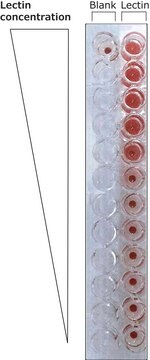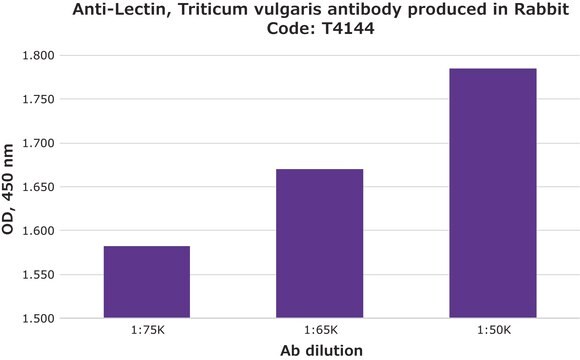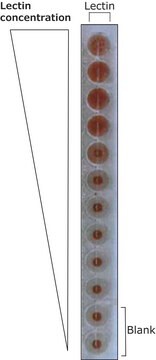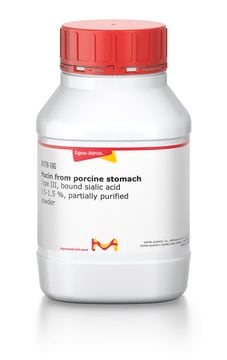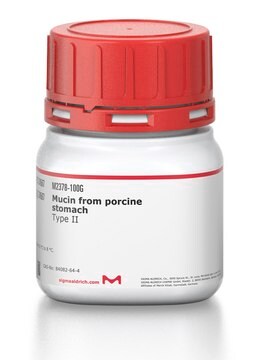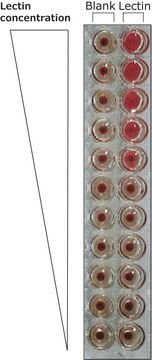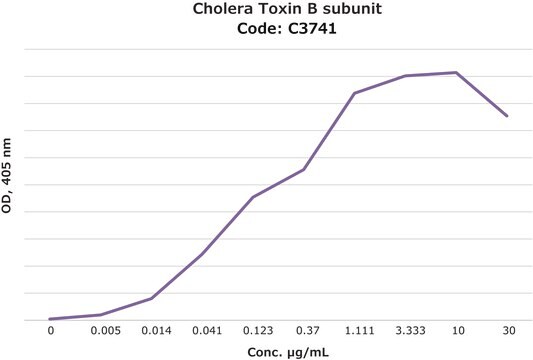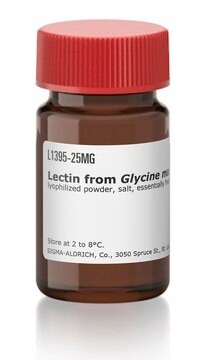L3892
Lectin from Triticum vulgaris (wheat)
peroxidase conjugate, lyophilized powder
Sinonimo/i:
WGA, Wheat germ agglutinin
Autenticatiper visualizzare i prezzi riservati alla tua organizzazione & contrattuali
About This Item
Codice UNSPSC:
12352202
NACRES:
NA.32
Prodotti consigliati
Origine biologica
Triticum vulgaris
Livello qualitativo
Coniugato
peroxidase conjugate
Saggio
≥85% protein basis (Warburg-Christian)
Stato
lyophilized powder
Potenza
<40 μg/mL agglutination activity
peroxidase activity
50-200 units/mg protein
Composizione
Protein, ~90% modified Warburg-Christian
Temperatura di conservazione
−20°C
Cerchi prodotti simili? Visita Guida al confronto tra prodotti
Applicazioni
Detects glycoproteins containing β(1→4)-N-acetyl-D-glucosamine when used with appropriate peroxidase substrate
General Western Blot Protocol:
- Glycoprotein sample size: 500ng
- Lectin Concentration: 0.1ug/ml
- Load samples at 500 ng of glycoprotein per lane
- Run 4-20% Bis-Tris SDS page gel
- Transfer gel to a PVDF membrane
- Block membrane for 1 hr at RT with RIPA buffer (R0278 Sigma)
- Incubate HRP lectin at 0.1ug/ml with RIPA buffer for 2 hours at RT
- Wash membrane 5 x 5 minutes with 25ml RIPA buffer
- Detect using chemiluminescent substrate (CPS1-120)
Azioni biochim/fisiol
WGA is not blood group specific but has an affinity for N-acetyl-β-D-glucosaminyl residues and N-acetyl-β-D-glucosamine oligomers. WGA contains no protein-bound carbohydrate.
Confezionamento
Package size based on protein content.
Definizione di unità
One unit will form 1.0 mg of purpurogallin from pyrogallol in 20 sec at pH 6.0 at 20 °C.
Stato fisico
Contains citrate buffer
Nota sulla preparazione
Conjugates are prepared from affinity purified lectin.
Prepared from peroxidase type VI (P8375) using a modification of the method of O′Sullivan, which favors low molecular weight conjugates. Repurified after conjugation by affinity chromatography.
Codice della classe di stoccaggio
11 - Combustible Solids
Classe di pericolosità dell'acqua (WGK)
WGK 3
Punto d’infiammabilità (°F)
Not applicable
Punto d’infiammabilità (°C)
Not applicable
Dispositivi di protezione individuale
Eyeshields, Gloves, type N95 (US)
Scegli una delle versioni più recenti:
Possiedi già questo prodotto?
I documenti relativi ai prodotti acquistati recentemente sono disponibili nell’Archivio dei documenti.
I clienti hanno visto anche
P O Gerrits et al.
Neuroscience, 161(2), 459-474 (2009-03-27)
In the hamster brainstem estrogen receptor-alpha-immunoreactive neurons (ER-alpha-IR) are present in the nucleus para-retroambiguus (NPRA), located in the caudal ventrolateral medulla (CVLM) ventrolaterally to the nucleus retroambiguus (NRA). NPRA neurons project mainly to the thoracic and upper lumbar cord and
Xinyu Qi et al.
Journal of bone and joint infection, 6(7), 241-253 (2021-07-16)
The high antibiotic tolerance of Staphylococcus aureus biofilms is associated with challenges for treating periprosthetic joint infection. The toxin-antitoxin system, YefM-YoeB, is thought to be a regulator for antibiotic tolerance, but its physiological role is unknown. The objective of this
Qian Guo et al.
Journal of bone and mineral research : the official journal of the American Society for Bone and Mineral Research, 36(10), 2065-2080 (2021-06-23)
ATP-citrate lyase (ACLY), generating most of the nucleocytosolic acetyl coenzyme A (acetyl-CoA) for histone acetylation, links cell metabolism to epigenetic regulation. Recent investigations demonstrated that ACLY activated by metabolic reprogramming played an essential role in both M1 and M2 macrophage
Hugo Aguilar-Díaz et al.
PLoS neglected tropical diseases, 4(2), e607-e607 (2010-02-20)
Inhibition of encystment can be conceived as a potentially useful mechanism to block the transmission of Entamoeba histolytica under natural conditions. Unfortunately, amoeba encystment has not been achieved in vitro and drugs inhibiting the formation of cysts are not available.
Qian Li et al.
Foods (Basel, Switzerland), 10(12) (2021-12-25)
Paeonol can effectively inhibit Aspergillus flavus (A. flavus) via damaging cell walls. In this work, paeonol treatment remarkably destroyed both the outer amorphous layer and the inner fibrous layer of cell walls. Furthermore, FT-IR and XPS characterization showed that OH
Il team dei nostri ricercatori vanta grande esperienza in tutte le aree della ricerca quali Life Science, scienza dei materiali, sintesi chimica, cromatografia, discipline analitiche, ecc..
Contatta l'Assistenza Tecnica.